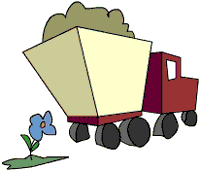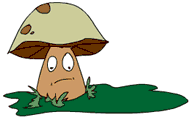Healthy soilProf Walker tells
us how to build up and maintain a healthy soil.
If we continually crop our soil, the soil organic matter slowly declines as the soil microbes decompose it. Every time we remove a crop from the soil, whether it be carrots or cabbages or potatoes, we also remove the nutrients with those crops, and our soil can become slowly depleted. So we have to make sure that, firstly, we maintain organic matter, and secondly, we maintain the supply of nutrients. WHAT IS SOIL ORGANIC MATTER? Soil organic matter includes the fresh organic plant material that's being added to the soil — the decomposing remains of spent plants or kitchen scraps for example. And when it's thoroughly decomposed and formed what we call humus, that's soil organic matter. WHY IS IT SO IMPORTANT? It contains nitrogen, and that nitrogen is going to be liberated and supply nitrate for plants to grow on. It also greatly improves the soil structure. WHERE DO YOU GET IT FROM? We've got lots of sources of organic matter in New Zealand. Firstly, we can bury our kitchen waste in our soil, or make it into compost. We can bury our crop residues as well, or make it into compost. Sawdust is a good source of organic matter, but it takes a lot of nitrogen to break it down, so it should be composted beforehand. I like to dig my crop residues straight into the soil — let the composting take place there. It's going to be decomposed by earthworms, beetles, microbes of all kinds, bacteria, fungi. When they decompose it, they excrete ammonia, which gets converted to nitrate by soil bacteria. Ammonium and nitrate are the two forms of nitrogen that all plants that can't fix their own nitrogen from the air require from the soil if they're to grow. That's why it's so vital to keep organic matter levels up in the soil.
We've got a good range of composts in New Zealand. We've got compost like Living Earth, made from garden waste mainly. We've got compost made from the gut contents of slaughtered animals, composted with bark. We've got compost made with sawdust and cow manure; sawdust in pig slurry. We've got poultry manure, collected on litter of various kinds. We've got spent mushroom compost. We're fortunate in having such a variety. HOW MUCH ORGANIC MATTER DO YOU NEED? To get that lovely friable condition, I find that, in addition to my green manures and my crop residues, I need to put on about a 5 cm depth of compost over the whole garden. That means a cubic metre will do about 20 square metres of soil. And when do I know that I need it? Well, my soil will become sticky, lumpy, cloddy. It becomes difficult to dig, difficult to make seedbeds. You'll know when your soil's poor. Get lots of organic matter into the soil. Whilst there are many things we can use to add organic matter to our soil, there's one problem — they can all differ very much in their chemical composition. They improve the PHYSICAL condition of our soil, but they can claim very different amounts of nutrients. Some will supply a lot of nitrogen. Some will supply very little. Some will be rich in potassium. Poultry manure is very rich compared with most. Why? Because, as far as I know, birds have only got one hole. So it ALL comes out — the liquid and solid all mixed up together. (It is a very rich material so it probably needs composting with sawdust or straw before use). Whereas if you just collect horse manure without the urine — or cow manure or sheep manure without the urine — you've got valuable nutrients missing. Because in the urine of mammals like us, we find nearly all the potassium we excrete and 75% of the nitrogen we excrete is in our urine as urea. 75% of the sulphur we excrete is in our urine as sulphite. So urine is a very valuable liquid fertiliser. Sheep pellets straight from the shearing shed with the urine mixed in would be a rich source of organic matter and nutrients. I often use a mushroom compost made with poultry manure. I like it because of the lime it contains, and I've used it a lot in my veggie garden. FIXING NITROGEN IN SOIL Legumes are nature's way of building up organic matter in the soil. But we did not know until 1885 why legumes were so important. They can fix their own nitrogen from the air, and the reason they can do it is because, if you dig up a clover plant — an invaluable legume — you will see, scattered over the root system, little nodules about the size of pinheads. Those nodules are filled with thousands of bacteria which fix nitrogen from the air. Clovers have been vital in our agriculture in New Zealand. We've depended on them in our pastures to provide lots of nitrogen and food for our animals. In Marlborough they're beginning to grow clovers between their rows of vines to supply not only nitrogen and organic matter, but also to attract the hoverfly, which controls aphids. And we can put legumes to use in our gardening too. We can grow peas, beans, clovers or lupins to build up nitrogen and organic matter. This year I've decided to grow red clover as a green manure. We've got a cultivar named Pawera that's a winter-growing clover, and I want to see if it does well in my soil over winter. Sow it directly into the hoed soil and rake the seed in. Then gently compact the soil. That's to keep the moisture rising. Remember, there's an important place for legumes like lupins and clovers for us to dig in and add organic matter and nitrogen to our soils. I can strongly recommend them.
|
Home | Journal
| Newsletter | Conferences
Awards | Join
RNZIH | RNZIH Directory | Links
© 2000–2025 Royal New Zealand Institute of Horticulture
Last updated: March 1, 2021


 When
we cultivate, we're growing plants more intensively than nature
ever meant, and this presents a problem.
When
we cultivate, we're growing plants more intensively than nature
ever meant, and this presents a problem.  But
I find that digging in all my crop residues and growing green manures
is still not enough to maintain my soil in good physical condition,
so I do have to bring in compost.
But
I find that digging in all my crop residues and growing green manures
is still not enough to maintain my soil in good physical condition,
so I do have to bring in compost. 